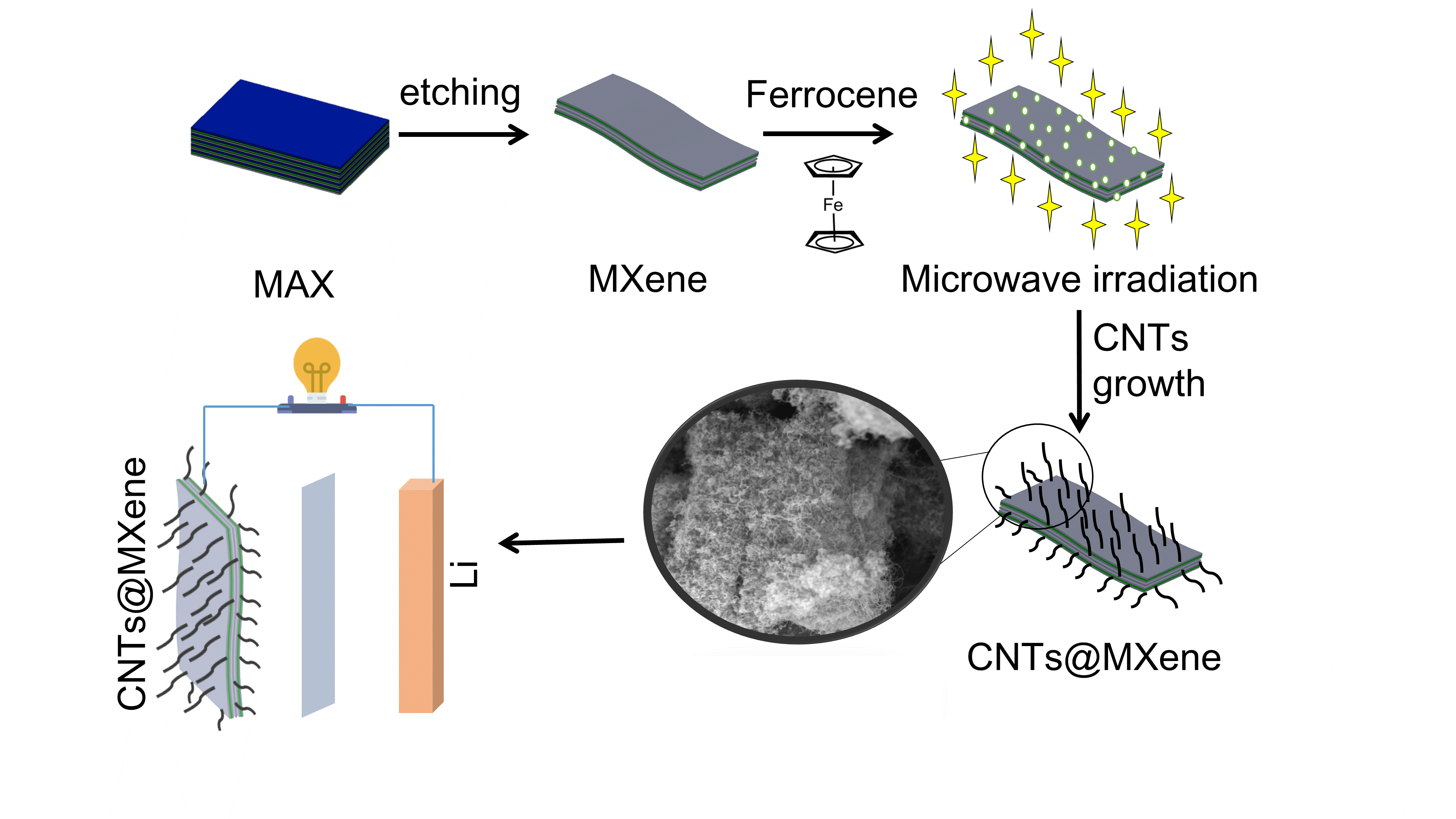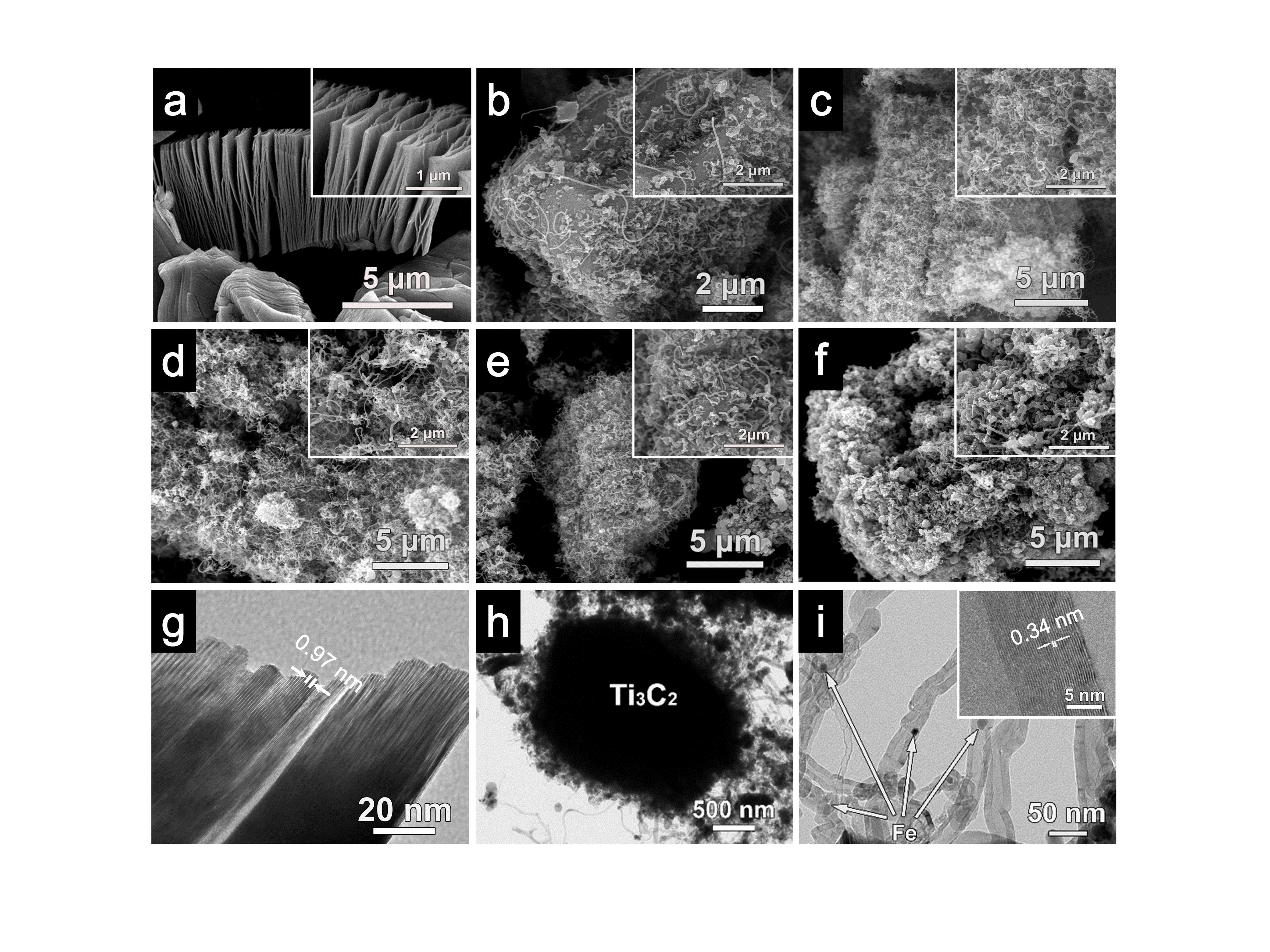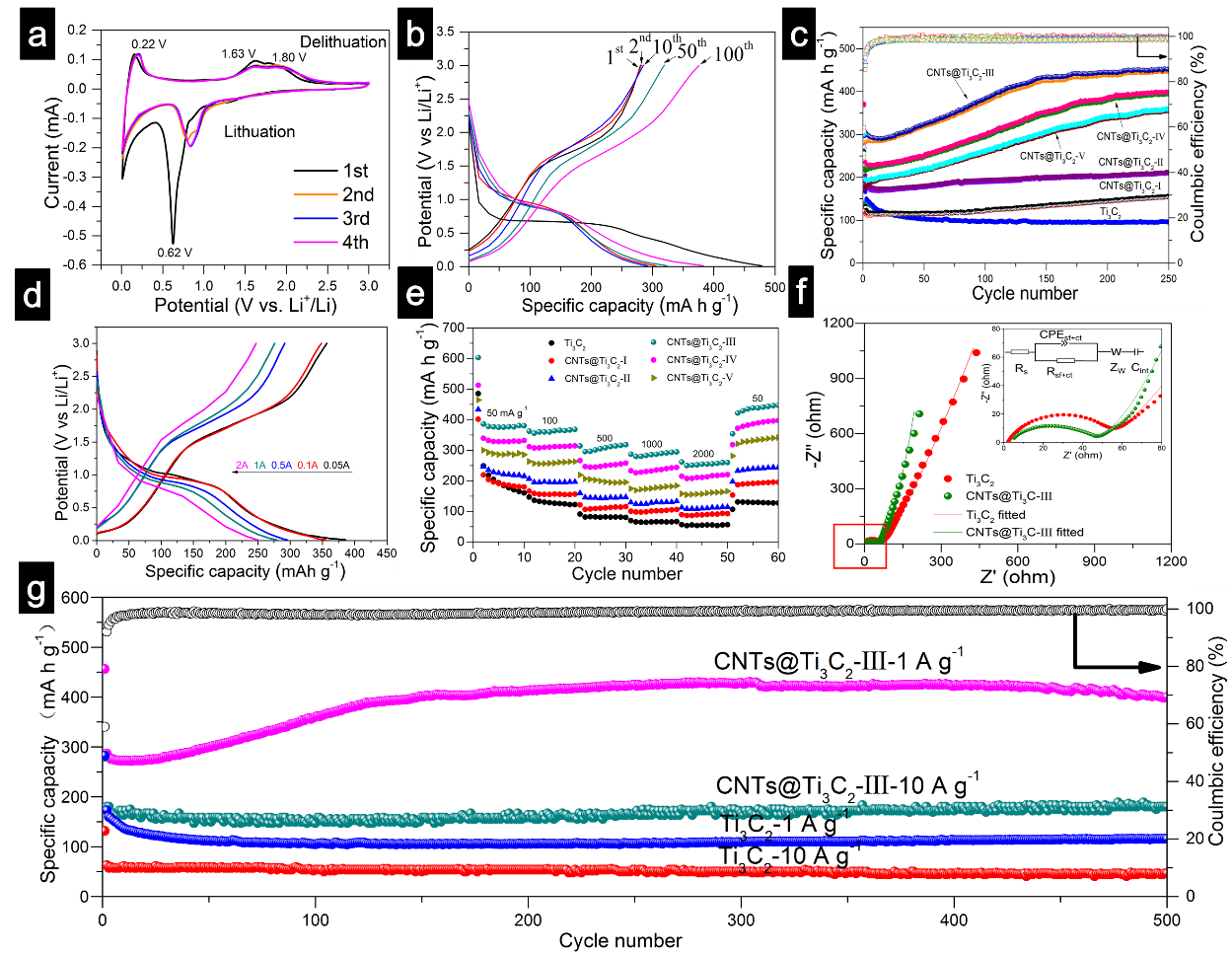原位合成具有优异储锂性能的CNTs@MXene复合材料
Sun group at Southeast University reported in-situ synthesis of CNTs@MXene hybrid structures by microwave irradiation for high-performance anodes in lithium ion batteries
MXene是一类新型二维材料,通式为Mn+1XnTx,其中M代表早期过渡金属,X是碳/氮,T代表MXene在刻蚀过程中产生的表面官能团(OH, -F, =O)。MXene由于较大的比表面积、高的导电性、亲水性和丰富可调的表面化学基团,在锂离子电池、超级电容器、燃料电池等储能领域具有极大的应用前景。但是MXene层间会自发塌缩和堆垛,大幅度降低MXene的比表面积,减少Li+的吸附位点,而且塌缩和堆垛会引发MXene垂直层间方向电阻率大幅增加,进一步阻碍Li+的传输。在MXene层间原位生长碳纳米管是行之有效的方法。
MXenes are a newly emerging family of two-dimensional (2-D) materials with the general formula Mn+1XnTx, where M represents early transition metal, X is carbon and/or nitrogen, and T stands for the surface termination groups (-OH, -F, =O). MXenes have demonstrated great potentials in energy storage fields such as Lithium-ion batteries (LIBs), supercapacitors and fuel cells for their large specific surface area, good electrical conductivity, hydrophilia and abundant tailorable surface chemistries etc. However, their intrinsic 2-D structures suffer from re-stacking and collapses in-service, such as discharge-charge cycles as anodes for LIBs. The addition of carbon nanotubes (CNTs) as spacers into MXenes has been demonstrated as an effective strategy to not only stabilize the layer structure, but also enhance the electrical conductivity.
目前常见的制备CNTs的方法是化学气相沉积(CVD),水热反应、高压CO转化等,但是CVD制备CNTs时,用时较长、设备复杂、需要高温真空设备,造价高,不利于推广应用。因此寻求新的制备方法极为迫切。
Different in-situ methods have been employed to synthesize CNTs, such as chemical vapor deposition (CVD), hydrothermal reaction, and high-pressure CO conversion (HiPco) and so on. CVD is favourable due to high-volume CNTs production. However, the CVD processes suffer from harsh conditions (such as vacuum or inert gas protection, high temperature and/or high energy density, complex reaction setup), time-consuming producing steps, energy inefficiency and environmental pollutions. Therefore, new technology is highly needed to tackle this issue.
最近,东南大学材料学院孙正明教授课题组突破上述难关,利用微波法在MXene上原位生长CNTs。该过程只需要40秒,就可以得到目标产物。当用于锂离子电池负极时,CNTs@MXene展现出优异的储锂性能。作者将此归因于CNTs的“桥梁”作用、金属/金属氧化物的高比容量和MXene基高导电性之间的协同作用。具体地,CNTs不仅起到支撑作用,还能促进电子和离子的传输;MXene的层间结构为CNTs提供了生长位点,形成的杂化结构有利于增强反应速度;CNTs包覆的金属/金属氧化物进一步提升了整体的容量。
Recently, Sun group in Southeast University broke through this difficulty. They devise a fast and scalable approach to the synthesis of CNTs-MXene hybrid nanostructures via microwave irradiation under ambient condition. CNTs were grown on MXene in only 40 seconds. The resulted CNTs@MXene nanostructures were tested as anodes in LIBs and it exhibits a better electrochemical performance. They believed that the impressive electrochemical performance is correlated to the synergetic effects among the hybrid structure including the connective CNTs bridges, large-capacity metal/metal oxides and the fine conductive MXene matrix. The CNTs not only act as the spacers between Ti3C2 sheets, but also boost the transport of electrons and ions. The fine conductive Ti3C2 sheets provide the large active sites to form the CNTs, and the resulted hybrid porous structure benefits the reaction kinetics of the electrode. The encapsulated metal/metal oxide nano-particles further increase the capacity.
值得一提是,该技术同样适用于其他二维材料,有望在储能领域得到关注。
It should be noted that this route can be easily applied to various MXenes and it can find applications in modulating the structure and properties for MXenes in various advanced applications.
该成果发表于Journal of Materials Chemistry A。文章的第一作者为东南大学材料学院博士研究生郑伟和张培根博士,通讯作者为陈坚教授与孙正明教授。
These findings have been published in the Journal of Materials Chemistry A. The first author is ZHENG Wei (a PhD candidate in Southeast University) and Dr. P. Zhang, with Prof. CHEN Jian and Prof. SUN ZhengMing as corresponding authors.
全文链接Full text URL: Click here (DOI: 10.1039/C7TA10394H)

▲ 图1 CNTs@MXene复合材料制备流程图
Fig. 1 Schematic showing the preparation of CNTs@MXene hybrids

▲ 图2 MXene及CNTs@MXene形貌图(MXene的“手风琴”状层状形貌以及CNTs在MXene上生长情况清晰可见。CNTs在MXene基体上生长符合“顶端生长模式”,且随着微波次数的增加,CNTs的密度和覆盖率逐渐增长。但是辐射三次之后,CNTs的量又表现出减少的趋势)
Fig. 2 Morphology of MXene and CNTs@MXene (The accordion-like structure of pristine MXene and the CNTs growing on the surface of MXene can be observed. CNTs were grown in the tip-growth model instead of base-growth model. The growth of CNTs on MXenes can be facilated by repeated irradiation (up to 3 cycles). However, with further increasing the cycles, the coverage of CNTs decreased and significant by-products)

▲ 图3 MXene及CNTs@MXene的电化学性能(微波三次的CNTs@MXene复合材料,在比容量、倍率性能和循环性能方面,均表现最好)
Fig. 3 Electrochemical performance of MXene and CNTs@MXene (CNTs@MXene-Ⅲ shows the best capacity, rate performance and cycle performance)
更多学术成果介绍: